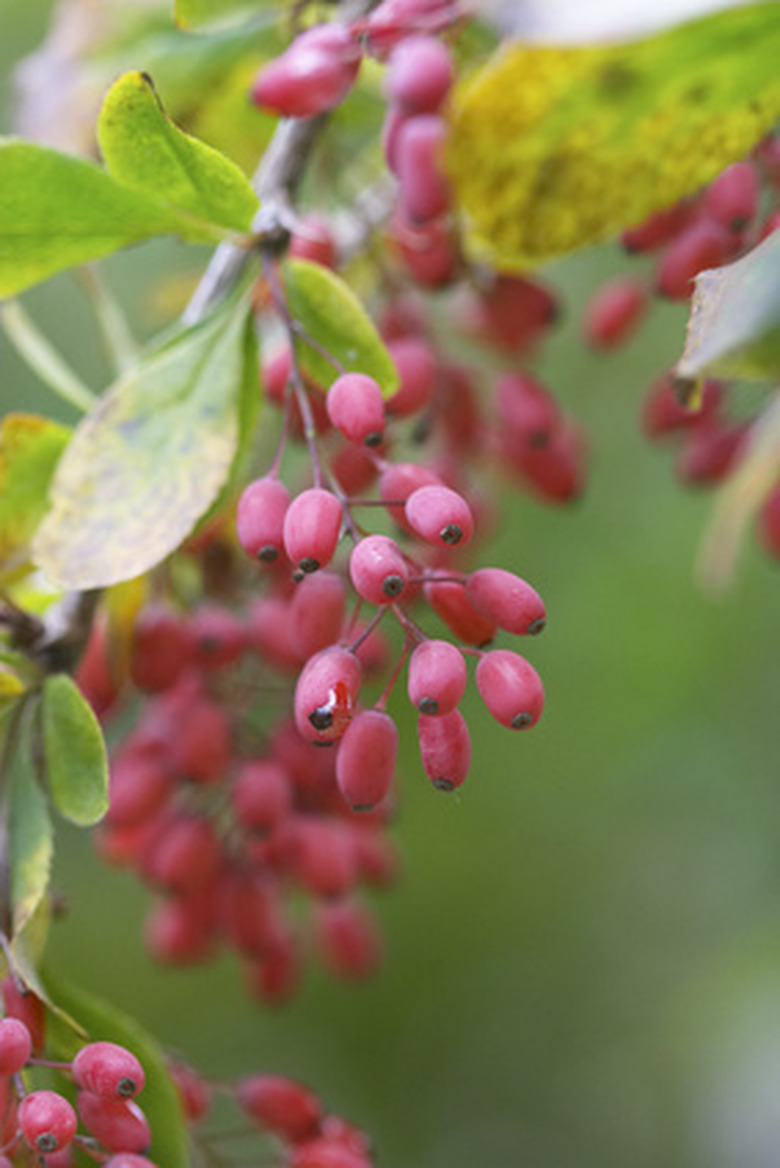How To Transplant A Large Barberry
Homeowners choose landscape plantings such as barberry for their handsome foliage and longevity. However, some plants simply exceed expectations for growth and require transplanting to accommodate their expansion. Moving an existing landscape shrub requires careful preparation of both the plant and the future planting site. Barberry shrubs are particularly challenging to transplant because of their sharp thorns. Fortunately, barberry is a hardy shrub that will tolerate transplanting regardless of size.
Preparation for Transplanting
Step 1
Prepare the barberry shrubs for transplanting at least six to nine months before the planned transplant by pruning the roots of the bush. Root pruning involves chopping off the roots under ground to encourage feeder root growth directly under the plant.
- Homeowners choose landscape plantings such as barberry for their handsome foliage and longevity.
- Barberry shrubs are particularly challenging to transplant because of their sharp thorns.
Step 2
Locate the outer perimeter of the foliage canopy to determine the correct size of the proposed root ball. Move the shovel blade in toward the shrub's trunk about 6 to 12 inches to create a manageable root ball. Place the shovel blade upright and step down to drive the shovel directly into the dirt. Lift the shovel straight out of the dirt without removing any soil.
Step 3
Place the blade one shovel's width away from the previous spade mark and step down again. Continue using the shovel around the entire shrub while adhering to the spacing of a shovel's width between cuts. This method chops off the roots at regular intervals while still maintaining some of the feeder roots that nourish the plant. New feeder roots will form in the cut areas.
- Locate the outer perimeter of the foliage canopy to determine the correct size of the proposed root ball.
- Continue using the shovel around the entire shrub while adhering to the spacing of a shovel's width between cuts.
Step 4
Schedule another root pruning four to six months after the initial pruning. Use the same method except place the shovel blade in the alternate areas around the shrub.
Transplanting the Shrub
Step 1
Carefully wrap a length of twine around the barberry limbs to lift the branches upward. Tie off the twine after tightening the rope around the bush. You may need multiple lengths of twine to secure the branches to prevent damage during transplant. This effort also protects the gardener, since barberry features sharp thorns along the length of all branches.
Step 2
Place the shovel blade 4 to 6 inches outside the original root-pruning shovel marks. This allows incorporation of the new feeder roots in the transplanted root ball. Dig around the perimeter of the shrub by stepping down firmly on the shovel to remove a section of soil. Clear as much soil as possible from around the roots to improve visibility.
- Schedule another root pruning four to six months after the initial pruning.
- Use the same method except place the shovel blade in the alternate areas around the shrub.
Step 3
Loosen the shrub's main roots by driving the shovel blade deeply below the main trunk. Work around the shrub from every angle to free it from the soil. Carefully lift the plant into the wheelbarrow for easy movement to the new planting site.
Step 4
Prepare the new planting site by stirring up the top 12 inches of soil with a cultivator or shovel. Incorporate 3 to 4 inches of peat moss or compost into the soil and mix well. Dig a hole roughly 2 times the size of the shrub's root ball.
Step 5
Position the plant into the hole, making sure the top of the root ball lies below the soil surface level. Add or remove more soil if necessary. Fill in around the barberry shrub, pressing the soil firmly to release air pockets.
- Loosen the shrub's main roots by driving the shovel blade deeply below the main trunk.
- Fill in around the barberry shrub, pressing the soil firmly to release air pockets.
Step 6
Water the plant thoroughly by directing the hose at the soil surface around the trunk. A slow steady drip will percolate into the soil and nourish those feeder roots to aid the plant in adjusting to the new planting site. Add a 3- to 4-inch layer of shredded mulch to improve moisture retention in the soil.
Tip
Remember the plant is already stressed from transplanting and can't tolerate lack of water. Water deeply into the soil at regular intervals, especially during times of little rainfall.
Things Needed
- Shovel
- Thick twine
- Wheelbarrow
- Cultivator
- Peat moss or compost
- Garden hose
- Mulch
